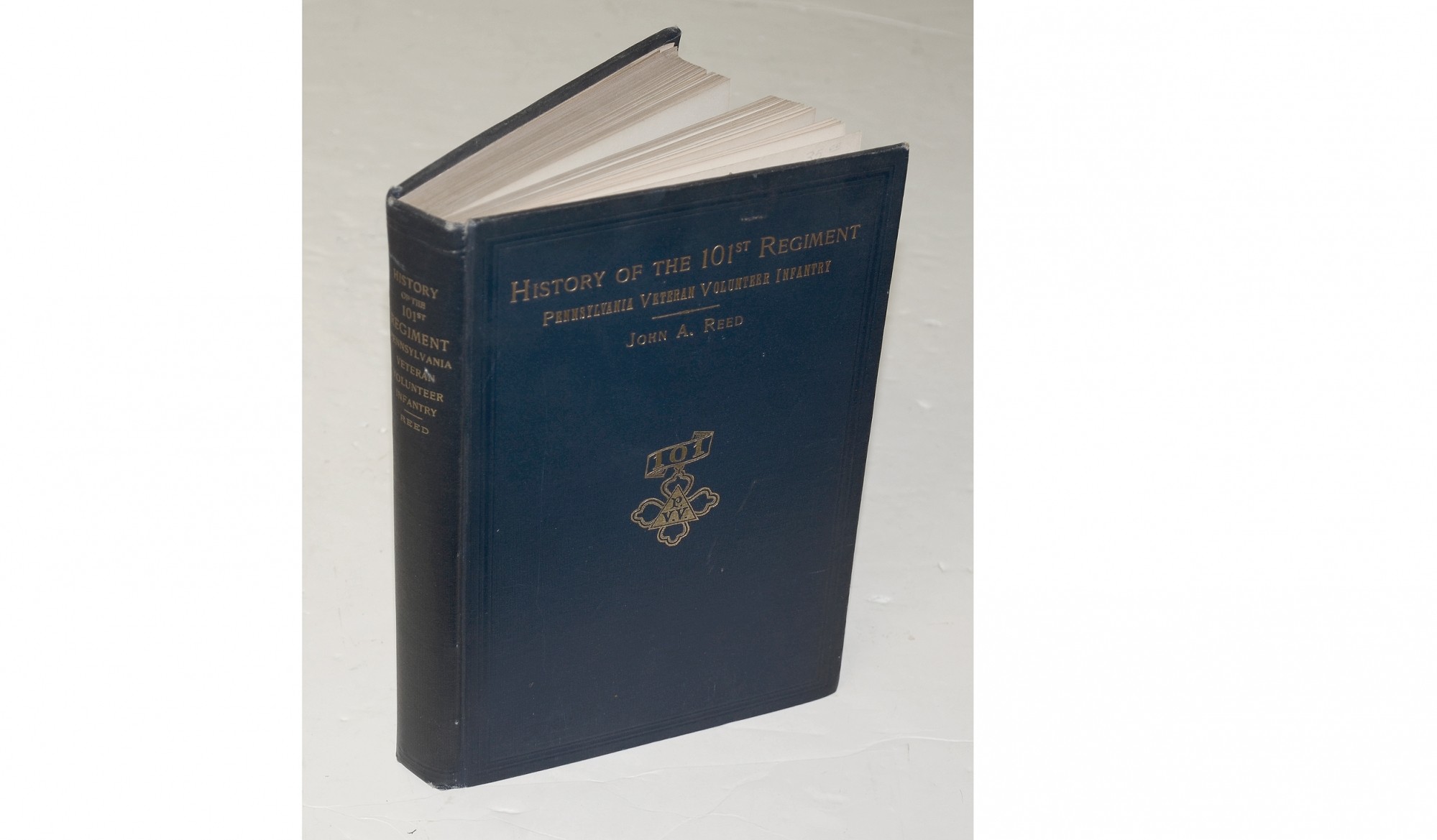site search
online catalog
HISTORY OF THE 101ST REGIMENT, PENNSYLVANIA VETERAN VOLUNTEER INFANTRY BY JOHN A. REED, 1910

$95.00 SOLD
Quantity Available: None
Item Code: 801-226
This volume was written by John A. Reed who was a Private in Co. “H”, 101st Pennsylvania Infantry. He was appointed 2nd Lieut., N.C. Union Vols. in December of 1863. It is a comprehensive account of the history of the 101st, drawn from the experiences of the veterans. It begins from their organization in August of 1861, and includes details about the battles they participated in, life in Confederate prison camps, monument dedications and veteran reunions. Included are several portraits and biographical sketches of members of the 101st, as well as illustrated maps. On the inside of the back cover, there is a fold-out map of North Carolina.
Book is dark blue cloth covered, and embossed with gold gilt lettering on the front cover and spine. It measures 10 ½” x 7 ¼” x 1 ¼”. Pages have slightly yellowed with age. The corners, as well as top and bottom of spine are slightly bent and distressed but overall, this volume is in excellent condition. Text contains 285 pages.
The commanding officers of the 101st Infantry were — Cols., Joseph H. Wilson, David B. Morris, James Sheafer; Lieut. -Cols., David B. Morris. Joseph S. Hoard, David M. Armour, Alexander W. Taylor, Melvin L. Clark; Majs., Joseph S. Hoard, David M. Armour, Alexander W. Taylor, David W. Mullin, Henry S. Benner. The 101st regiment, of which seven companies were recruited in the counties of Allegheny, Beaver and Lawrence, and three in the counties of Tioga, Bedford and Adams, was organized at Camp Curtin, Harrisburg, late in the autumn of 1861 and there mustered into the U. S. service for a three years' term. On Feb. 27, 1862, it left for Washington and was assigned to the 2nd brigade, 3d division, 4th corps, under Gen. Keyes. On March 28 it moved to Newport News and was soon actively engaged in the operations on the Peninsula. It took part in the siege of Yorktown, the battle of Williamsburg, and in the Battle of Fair Oaks its losses were very heavy, but the behavior of the men was most heroic. Various details occupied the regiment during the Seven Days' battles, after which it was stationed at Suffolk from Sept. 18 to Dec. 4, when it was ordered to New Berne, N. C, to join the expedition to Goldsboro. The enemy was encountered at Kinston, Whitehall and Goldsboro, but the object of the movement, the destruction of the railroad bridge, was accomplished and the troops returned to New Berne, near which city they went into winter quarters. The next movement of importance was the relief of Little Washington in April, 1863. After an unsuccessful attempt to reach the city by water, another effort was made by land, and after a sharp encounter with the enemy at Swift creek a force was able to reach Little Washington. The regiment was stationed at Plymouth from July, 1863, to April, 1864, and there early in 1864 a large proportion of the members reenlisted. It made many excursions into the surrounding country, frequently encountering detachments of Confederate troops, and in March, 1864, was ordered for a short time to Roanoke Island. Returning to Plymouth in April, Gen. Hoke's large force approached and after three days' resistance the forts were obliged to surrender, the entire 101st being captured. The officers were imprisoned at Macon and the men at Andersonville. A few afterward escaped, some were exchanged during that summer, but the remainder were held in prison until the summer of 1865, and over half of the number died. Those of the regiment who were absent on leave or with the sick at Roanoke island, with such of the prisoners as were exchanged, kept up the regimental organization and received in March, 1865, eight new companies, which were, however, never incorporated with the original members. The regiment was mustered out at New Berne, N. C. on June 25, 1865.
The 101st was nicknamed the "Keystone Regiment". Edward Boots - 101st PA Historian wrote about them, "No regiment that served through the Civil War from the state of Pennsylvania was more representative of the entire citizenship of the State than was the 101st Regiment. Not only representing all sections of the State it also represented all classes such as professional men, the merchant, the mechanic, the farmer, and common laborer."
Regiment lost during service- 39 enlisted men killed and mortally wounded, 1 Officer and 281 enlisted men by disease. Total 321 casualties.
~~~~~~~~~~~~~~~~~~~~~~~~~
THIS ITEM, AS WITH ALL OTHER ITEMS AVAILABLE ON OUR WEB SITE,
MAY BE PURCHASED THROUGH OUR LAYAWAY PROGRAM.
FOR OUR POLICIES AND TERMS,
CLICK ON ‘CONTACT US’ AT THE TOP OF ANY PAGE ON THE SITE,
THEN ON ‘LAYAWAY POLICY’.
THANK YOU!
Inquire About HISTORY OF THE 101ST REGIMENT, PENNSYLVANIA VETERAN VOLUNTEER INFANTRY BY JOHN A. REED, 1910
For inquiries, please email us at [email protected]
Most Popular
Historical Firearms Stolen From The National Civil War Museum In Harrisburg, Pa »
Theft From Gravesite Of Gen. John Reynolds »
Cavalry Carbine Sling Swivel »
Fine Condition Brass Infantry Bugle Insignia »
featured item
REMARKABLE SWORD IDENTIFIED TO GEORGE WILLIAM GORDON (1801-1877), US CONSUL TO BRAZIL (1840-46) AND SLAVE TRADE OPPONENT
A remarkable sword manufactured by W.H. Horstmann & Co., New York after the Model 1834 US Revenue Cutter/Marine sword. Neatly engraved on the reverse folding guard, “Geo. Wm. Gordon / United States Consul”. Born on February 8, 1801 in Exeter,… (870-60). Learn More »





